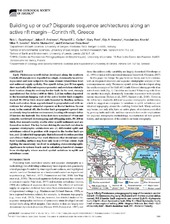| dc.contributor.author | Gawthorpe, Rob | |
| dc.contributor.author | Andrews, Julian E. | |
| dc.contributor.author | Collier, Richard E.L.I. | |
| dc.contributor.author | Ford, Mary | |
| dc.contributor.author | Henstra, Gijs Allard | |
| dc.contributor.author | Kranis, Haralambos | |
| dc.contributor.author | Leeder, Mike R. | |
| dc.contributor.author | Muravchik, Martin | |
| dc.contributor.author | Skourtsos, Emmanuel | |
| dc.date.accessioned | 2018-08-10T13:30:12Z | |
| dc.date.available | 2018-08-10T13:30:12Z | |
| dc.date.issued | 2017-12 | |
| dc.Published | Gawthorpe R L, Andrews JE, Collier RE, Ford M, Henstra G A, Kranis H, Leeder MR, Muravchik M, Skourtsos. Building up or out? Disparate sequence architectures along an active rift margin-Corinth rift, Greece. Geology. 2017;45(12):1111-1114 | eng |
| dc.identifier.issn | 1943-2682 | en_US |
| dc.identifier.issn | 0091-7613 | en_US |
| dc.identifier.uri | https://hdl.handle.net/1956/18042 | |
| dc.description.abstract | Early Pleistocene synrift deltas developed along the southern Corinth rift margin were deposited in a single, dominantly lacustrine depocenter and were subject to the same climate-related base-level and sediment supply cyclicity. Two synrift deltas, just 50 km apart, show markedly different sequence geometry and evolution related to their location along the evolving border fault. In the west, strongly aggradational fan deltas (>600 m thick; 2–4 km radius) deposited in the immediate hanging wall of the active border fault comprise stacked 30–100 m thick stratal units bounded by flooding surfaces. Each unit evolves from aggradational to progradational with no evidence for abrupt subaerial exposure or fluvial incision. In contrast, in the central rift, the border fault propagated upward into an already deep lacustrine environment, locating rift-margin deltas 15 km into the footwall. The deltas here have a radius of >9 km and comprise northward downstepping and offlapping units, 50–200 m thick, that unconformably overlie older synrift sediments and are themselves incised. The key factors driving the marked variation in sequence stratigraphic architecture are: (1) differential uplift and subsidence related to position with respect to the border fault system, and (2) inherited topography that influenced shoreline position and offshore bathymetry. Our work illustrates that stratal units and their bounding surfaces may have only local (<10 km) extent, highlighting the uncertainty involved in assigning chronostratigraphic significance to systems tracts and in calculating base-level changes from stratigraphy where marked spatial variations in uplift and subsidence occur. | en_US |
| dc.language.iso | eng | eng |
| dc.publisher | The Geological Society of America | en_US |
| dc.rights | Attribution CC BY | eng |
| dc.rights.uri | http://creativecommons.org/licenses/by/4.0 | eng |
| dc.title | Building up or out? Disparate sequence architectures along an active rift margin-Corinth rift, Greece | en_US |
| dc.type | Peer reviewed | |
| dc.type | Journal article | |
| dc.date.updated | 2018-03-06T13:30:09Z | |
| dc.description.version | publishedVersion | en_US |
| dc.rights.holder | Copyright 2017 The Author(s) | en_US |
| dc.identifier.doi | https://doi.org/10.1130/g39660.1 | |
| dc.identifier.cristin | 1549402 | |
| dc.source.journal | Geology | |

